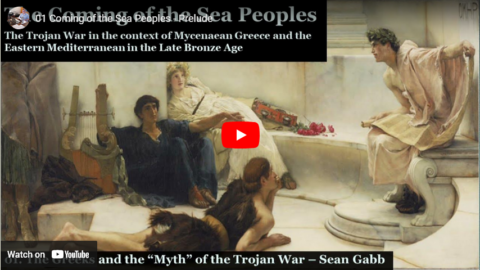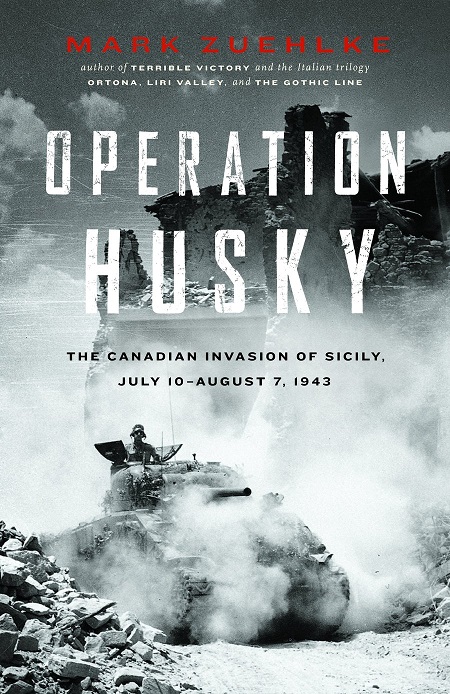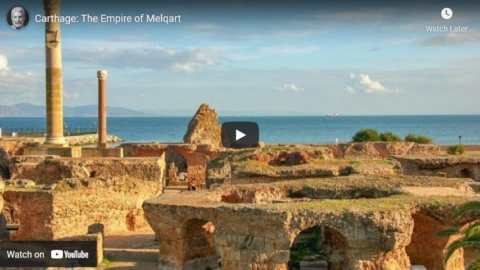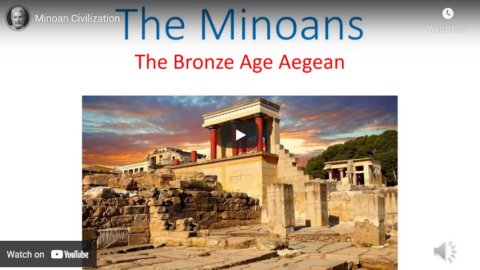Real Time History
Published 7 Jul 2023The summer of 1944 saw the Allies land in France not once but twice. Two months after Operation Overlord, the Allies also landed in Southern France during Operation Dragoon. It was “the perfect landing” and opened up the important ports of Marseille and Toulon for Allied logistics.
(more…)
July 8, 2023
The Perfect D-Day That History Forgot
February 5, 2023
QotD: Annual cycles of plenty and scarcity in pre-modern agricultural societies
This brings us to the most fundamental fact of rural life in the pre-modern world: the grain is harvested once a year, but the family eats every day. Of course that means the grain must be stored and only slowly consumed over the entire year (with some left over to be used as seed-grain in the following planting). That creates the first cycle in agricultural life: after the harvest, food is generally plentiful and prices for it are low […] As the year goes on, food becomes scarcer and the prices for it rise as each family “eats down” their stockpile.
That has more than just economic impacts because the family unit becomes more vulnerable as that food stockpile dwindles. Malnutrition brings on a host of other threats: elevated risk of death from injury or disease most notably. Repeated malnutrition also has devastating long-term effects on young children […] Consequently, we see seasonal mortality patterns in agricultural communities which tend to follow harvest cycles; when the harvest is poor, the family starts to run low on food before the next harvest, which leads to rationing the remaining food, which leads to malnutrition. That malnutrition is not evenly distributed though: the working age adults need to be strong enough to bring in the next harvest when it comes (or to be doing additional non-farming labor to supplement the family), so the short rations are going to go to the children and the elderly. Which in turn means that “lean” years are marked by increased mortality especially among the children and the elderly, the former of which is how the rural population “regulates” to its food production in the absence of modern birth control (but, as an aside: this doesn’t lead to pure Malthusian dynamics – a lot more influences the food production ceiling than just available land. You can have low-equilibrium or high-equilibrium systems, especially when looking at the availability of certain sorts of farming capital or access to trade at distance. I cannot stress this enough: Malthus was wrong; yes, interestingly, usefully wrong – but still wrong. The big plagues sometimes pointed to as evidence of Malthusian crises have as much if not more to do with rising trade interconnectedness than declining nutritional standards). This creates yearly cycles of plenty and vulnerability […]
Next to that little cycle, we also have a “big” cycle of generations. The ratio of labor-to-food-requirements varies as generations are born, age and die; it isn’t constant. The family is at its peak labor effectiveness at the point when the youngest generation is physically mature but hasn’t yet begun having children (the exact age-range there is going to vary by nuptial patterns, see below) and at its most vulnerable when the youngest generation is immature. By way of example, let’s imagine a family (I’m going to use Roman names because they make gender very clear, but this is a completely made-up family): we have Gaius (M, 45), his wife, Cornelia (39, F), his mother Tullia (64, F) and their children Gaius (21, M), Secundus (19, M), Julia1 (16, F) and Julia2 (14, F). That family has three male laborers, three female laborers (Tullia being in her twilight years, we don’t count), all effectively adults in that sense, against 7 mouths to feed. But let’s fast-forward fifteen years. Gaius is now 60 and slowing down, Cornelia is 54; Tullia, we may assume has passed. But Gaius now 36 is married to Clodia (20, F; welcome to Roman marriage patterns), with two children Gaius (3, M) and Julia3 (1, F); Julia1 and Julia2 are married and now in different households and Secundus, recognizing that the family’s financial situation is never going to allow him to marry and set up a household has left for the Big City. So we now have the labor of two women and a man-and-a-half (since Gaius the Elder is quite old) against six mouths and the situation is likely to get worse in the following years as Gaius-the-Younger and Clodia have more children and Gaius-the-Elder gets older. The point of all of this is to note that just as risk and vulnerability peak and subside on a yearly basis in cycles, they also do this on a generational basis in cycles.
(An aside: the exact structure of these generational patterns follow on marriage patterns which differ somewhat culture to culture. In just about every subsistence farming culture I’ve seen, women marry young (by modern standards) often in their mid-to-late teens, or early twenties; that doesn’t vary much (marriage ages tend to be younger, paradoxically, for wealthier people in these societies, by the by). But marriage-ages for men vary quite a lot, from societies where men’s age at first marriage is in the early 20s to societies like Roman and Greece where it is in the late 20s to mid-thirties. At Rome during the Republic, the expectation seems to have been that a Roman man would complete the bulk of their military service – in their twenties and possibly early thirties – before starting a household; something with implications for Roman household vulnerability. Check out Rosenstein, op. cit. on this).
On top of these cycles of vulnerability, you have truly unpredictable risk. Crops can fail in so many ways. In areas without irrigated rivers, a dry spell at the wrong time is enough; for places with rivers, flooding becomes a concern because the fields have to be set close to the water-table. Pests and crop blights are also a potential risk factor, as of course is conflict.
So instead of imagining a farm with a “standard” yield, imagine a farm with a standard grain consumption. Most years, the farm’s production (bolstered by other activities like sharecropping that we’ll talk about later) exceed that consumption, with the remainder being surplus available for sale, trade or as gifts to neighbors and friends. Some years, the farm’s production falls short, creating that shortfall. Meanwhile families tend to grow to the size the farm can support, rather than to the labor needs the farm has, which tends to mean too many hands (and mouths) and not enough land. Which in turn causes the family to ride a line of fairly high risk in many cases.
All of this is to stress that these farmers are looking to manage risk through cycles of vulnerability […]
I led in with all of that risk and vulnerability because without it just about nothing these farmers do makes a lot of sense; once you understand that they are managing risk, everything falls into place.
Most modern folks think in terms of profit maximization; we take for granted that we will still be alive tomorrow and instead ask how we can maximize how much money we have then (this is, admittedly, a lot less true for the least fortunate among us). We thus tend to favor efficient systems, even if they are vulnerable. From this perspective, ancient farmers – as we’ll see – look very silly, but this is a trap, albeit one that even some very august ancient scholars have fallen into. These are not irrational, unthinking people; they are poor, not stupid – those are not the same things.
But because these households wobble on the edge of disaster continually, that changes the calculus. These small subsistence farmers generally seek to minimize risk, rather than maximize profits. After all, improving yields by 5% doesn’t mean much if everyone starves to death in the third year because of a tail-risk that wasn’t mitigated. Moreover, for most of these farmers, working harder and farming more generally doesn’t offer a route out of the small farming class – these societies typically lack that kind of mobility (and also generally lack the massive wealth-creation potential of industrial power which powers that kind of mobility). Consequently, there is little gain to taking risks and much to lose. So as we’ll see, these farmers generally sacrifice efficiency for greater margins of safety, every time.
Bret Devereaux, “Collections: Bread, How Did They Make It? Part I: Farmers!”, A collection of Unmitigated Pedantry, 2020-07-24.
December 16, 2022
Coming of the Sea Peoples: Part 1 – Prelude
seangabb
Published 1 May 2021The Late Bronze Age is a story of collapse. From New Kingdom Egypt to Hittite Anatolia, from the Assyrian Empire to Babylonia and Mycenaean Greece, the coming of the Sea Peoples is a terror that threatens the end of all things. Between April and July 2021, Sean Gabb explored this collapse with his students. Here is one of his lectures. All student contributions have been removed.
More by Sean Gabb on the Ancient World: https://www.classicstuition.co.uk/
Learn Latin or Greek or both with him: https://www.udemy.com/user/sean-gabb/
His historical novels (under the pen name “Richard Blake”): https://www.amazon.co.uk/Richard-Blak…
November 8, 2022
Look at Life — Underwater Menace (1969)
PauliosVids
Published 20 Nov 2018Dealing with the hazardous legacy of World War II.
September 19, 2022
City Minutes: Crusader States
Overly Sarcastic Productions
Published 13 May 2022Crusading is one thing, but holding your new kingdoms is a much trickier business. See how the many Christian states of “Outremer” rolled with the punches to evolve in form and function over multiple centuries.
(more…)
September 11, 2022
Are we looking at a modern equivalent to the Bronze Age Collapse?
If you’re feeling happy and optimistic, Theophilus Chilton has a bucket of cold water to douse you with:
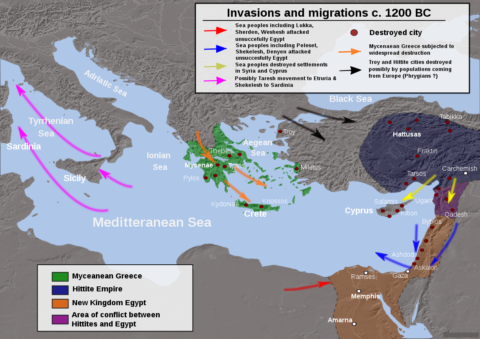
Migrations, invasions and destructions during the end of the Bronze Age (c. 1200 BC), based on public domain information from DEMIS Mapserver.
Map by Alexikoua via Wikimedia Commons.
Regular readers know that I’ve talked about collapse (as well as the implied regeneration that follows it) on here a lot. In nearly all cases, though, I’ve discussed it within a specifically American context – the collapse of the present American system and the potential for one or more post-American successor states arising in place of the present globohomo order. However, we should recognise that collapse is a general phenomenon that affects any and all large nations eventually. Just as America is not a special snowflake who is exempt from the laws of demographic-structural theory, so also is she not the only one subject to them.
Further in this vein, we should recognise that no major nation is isolated from its neighbours. No matter how self-sufficient, sooner or later everybody gets hooked up into trade networks. As trade networks expand, you develop world systems that display increased international interconnectedness and interdependency. From a demographic-structural perspective, the interconnectedness of these global systems acts to “synch up” the secular cycles of the nations involved as “information flows” increase. The upside to this is that when one part of the system prospers, everyone does. The downside, of course, is that when one part collapses, everyone does as well.
There are several historical examples of this kind of interconnected system synching up and then collapsing. Probably one of the most well-known examples would be the Bronze Age collapse which occurred in the Mediterranean world system roughly between 1225-1150 BC. Likely due to several shocks to the system working in tandem (drought, volcanic eruptions, migrations into the Balkans from the north, etc.), a series of invasions of the Sea Peoples spread out across the entire eastern end of the Mediterranean, toppling Mycenaean Greece and the Hittite Empire, and nearly did the same to Egypt. From there, the shocks moved outward throughout the rest of Anatolia and Syro-Palestine and eastward into Mesopotamia, disrupting the entire interconnected trade network. The system was apparently already primed to be toppled by these jolts, however, due to the top-heavy political structures (elite overproduction) and overspecialisation in these empires that contributed to their fragility in the face of system shocks. When the first one fell, the effects spread out like dominoes falling in a row.
There is evidence that this collapse extended beyond the Mediterranean basin and disrupted the civilisation existing in the Nordic Bronze Age around the Baltic Sea. Right around the same time that Bronze Age Mediterranean society was collapsing, serious changes to society in the Baltic basin were also taking place, primarily due to the disruption of trade routes that connected the two regions, with amber flowing south and metals and prestige goods returning north. During this period, the population in the area transitioned from a society organised primarily around scattered villages and farms into one that became more heavily militarised and centred around fortified towns, indicating that there was a change in the region’s elite organisation, or at least a strong modification of it (remember that collapse phases are characterised by struggles between competing elite groups). A large battle that dates to this era has been archaeologically uncovered in the Tollense Valley of northeastern Germany which is thought to have involved over 5000 combatants — a huge number for this area at this time, indicating more centralised state-like organisational capacities than were previously thought to have existed in the region. All in all, the evidence seems to suggest that this culture underwent some type of collapse phase at this time, likely in tandem with that occurring further south.
Other times and places have also seen such world system collapses take place. for instance, when the western Roman Empire was falling in the 3rd-5th centuries AD, the entire Mediterranean basis (again) underwent a systemwide socioeconomic collapse and decentralisation. More recently, the entire Eurasian trade system, from England to China, underwent a synchronised collapse phase in the early 17th century AD that saw revolutions, elite conflict, decentralisation, and social simplification take place across the length of the continent.
The great irony of interconnectedness is that too much of it actually works to reduce resilience within a system. Because an intensively globalised world system entails a lot of specialisation as different parts begin to focus on the production of different commodities needed within the network, this makes each part of the system more dependent upon the others. This works to reduce the resiliency of each of these individual parts, and the greater interconnectedness allows failure in one part to be communicated more widely and rapidly to other parts than might otherwise be the case in less interconnected systems.
July 14, 2022
The plight of 1st Canadian Infantry Division during the opening stages of Operation Husky, July 1943
First Canadian Infantry Division had an exciting start to Operation Husky — for certain values of “exciting” — as told in Mark Zuehlke’s Operation Husky: The Canadian Invasion of Sicily, July 10-August 7, 1943:
Every day [during the convoy to Sicily], Major General Guy Simonds and Lieutenant Colonel George Kitching performed the same macabre ritual. Kitching would take a hat filled with equal-sized chits of paper on which the names of every ship bearing Canadian personnel and equipment was written and hold it out to the divional commander. Simonds drew three chits and those three ships were declared lost, victims of torpedoes from a German U-boat — the scenario at times being that about one thousand men aboard the fast convoy had drowned and burned in oil-drenched seas, or hundreds of trucks, tanks, guns, radios, and other equipment in the slow convoy had plummeted to the bottom of the Mediterranean. All lost, gone. Kitching and his staff would then sit down and coldly “examine the effect the loss of these three ships would have on our projected plans.”
On July 3, Simonds pulled from the hat chits for three ships travelling in the Slow Assault Convoy — City of Venice, St. Essylt, and Devis. The coincidence was chilling, for it was aboard these vessels that equal portions of the divisional headquarters equipment — including all the trucks, Jeeps, radio sets, and a panoply of other gear that kept a division functioning — had been distributed. Were one or even, God forbid, two of these ships sunk, the headquarters could function almost as normal. But lose the three and the division was crippled.
Kitching considered the “chance of all three ships being sunk as a million to one”. Deciding there was no point in studying the implications of such a wildly remote possibility, he asked Simonds to draw another three names from the hat, which the general did.
As you’ve probably already figured out, the one-in-a-million situation turned up on schedule. City of Venice took a torpedo during a submarine alert, with Royal Navy escort ships dropping depth charges on a suspected U-boat position. The convoy instructions were for damaged ships to be left behind and for the undamaged ships to carry on, as the danger was greater if the whole convoy slowed or stopped to aid the stricken ship(s). City of Venice could not be saved, and ten crew members and ten Canadian soldiers were killed, but the other 462 men on board were transferred to a rescue ship. A few hours later, two more ships from the convoy were lost: St. Essylt, and Devis.
While the loss of lives aboard the three torpedoed slow convoy ships was relatively small, the amount and nature of equipment and stores sent to the bottom of the Mediterranean was serious. A total of 562 vehicles were lost, leaving 1st Canadian Infantry Division facing a major transportation shortage. Also lost were fourteen 25-pounders [gun-howitzers], eight 17-pounders [heavy anti-tank guns, equivalent to German 88mm guns], and ten 6-pounder anti-tank guns that would significantly reduce the division’s artillery support. “In addition to the above,” the divisional historical officer, Captain Gus Sesia, noted in his diary, “we lost great quantities of engineers’ stores and much valuable signals equipment.” The biggest immediate blow was the loss of all divisional headquaters vehicles and equipment, including many precious wireless sets — precisely the nightmare scenario forecast and rejected by Kitching as infeasible when Simonds had drawn these ships by lot a few days earlier.
Equally serious was the loss in equipment and lives suffered by the Royal Canadian Army Medical Coprs personnel attached to the division. Due to a loading error, instead of No. 9 Field Ambulance’s vehicles being distributed among several ships, fifteen out of eighteen were on Devis. Accompanying the vehicles was a medical officer and nineteen other ranks and medical orderlies. Four of the other ranks were among the fifty-two Canadian troops killed and another four suffered injuries. The other field ambulance, field dressing station, and field surgery units assigned to the division were largely unaffected. No. 5 Field Ambulance’s vehicles had been distributed correctly so only two of them and a ton of medical supplies went down with St. Essylt. City of Venice had just one medical officer, Captain K.E. Perfect, aboard and he escaped uninjured. But Perfect was overseeing safe passage of nine tons of stretchers and blankets, which all went to the bottom.
[…]
A fully accounting of the losses would not be completed for days. Even on July 7, reports were still coming in that City of Venice remained under tow and bound for Algiers. Finally, at 1900 hours on that day, its sinking was confirmed. The report also stated that most of the surviving Canadian troops had been loaded on a Landing Craft, Infantry in Algiers and were en route for Malta. From there, they would eventually rejoin the division.
Compounding the loss of so many vehicles was the fact that the division had left Britain with a smaller than mandated number due to lack of shipping capacity. Once the seriousness of the situation was appreciated, Lieutenant Colonel D.G.J. Farquharson, the division’s assistant director of ordnance services, and his staff “tried to make [the losses] good … by emergency measures, improvising and obtaining what could be obtained buckshee from the Middle East.” They soon had commitments for some vehicles, but these would not be available until after the initial landings. The fact that every vehicle to be found locally was a Dodge posed “a considerable ordnance problem, because what spare parts we had were based on Ford and Chevrolet makes.” Improvisation would be the order of the day.
July 5, 2022
How to Fool a Führer – Operation Mincemeat – WW2 – Spies & Ties 19
World War Two
Published 4 Jul 2022Glyndwr Michael, the dead secret agent, has deposited his deceptive letters in Spain. Now the next phase of Operation Mincemeat begins. If Charles Cholmondely of MI5 and Ewen Montagu of Naval Intelligence have done their job right, the letters should make their way into Hitler’s hands.
(more…)
June 19, 2022
Kursk: Soviets Dig-In for Blitzkrieg – WW2 – 199 – June 18, 1943
World War Two
Published 18 Jun 2022The Soviets have put civilians to work by the hundreds of thousands, building line after line of defenses in the Kursk salient, where they are sure the Germans are soon to attack. Meanwhile the Allies are making moves in preparations for two big upcoming offensives of their own — in Sicily and the Central Solomon Islands.
(more…)
June 12, 2022
Eisenhower Lays Out His Plans for Sicily – WW2 – 198 – June 11, 1943
World War Two
Published 11 Jun 2022The Allies bomb Mediterranean islands in preparation for their invasion of Sicily next month; they also prepare a lot of deceptions to mislead the enemy as to where they will attack. The German plans for the summer offensive against the Kursk salient are ever more concrete, and in the field this week, the Chinese stop the Japanese offensive cold.
(more…)
May 14, 2022
QotD: The farming cycle in pre-modern Mediterranean cultures
As you might imagine, time in agriculture is governed by the seasons. Crops must be planted at particular times, harvested at particular times. In most ancient societies, the keeping of the calendar was a religious obligation, a job for educated priests (either a professional priestly class as in the Near East, or local notables serving as amateurs, as in Greece and Rome).
The seasonal patterns vary a bit depending on the conditions and the sort of wheat being sown. In much of the Mediterranean, where the main concern was preserving a full year’s moisture for the crop, planting was done in autumn (November or October) and the crop was harvested in early summer (typically July or August). In contrast, the Han agricultural calendar for wheat planted in the spring, weeded over the summer and harvested in fall. The Romans generally kept to the autumn-planting schedule, except our sources note that on land which was rich enough (and wet enough) to be continuously cropped year after year (without a fallow), the crop was sown in spring; this might also be done in desperation if the autumn crop had failed. In Egypt, sowing was done as the Nile’s flood waters subsided at the beginning of Peret (in January), with the harvest taking place in Shemu (summer or early fall).
(As an aside on the seasons: we think in terms of four seasons, but many Mediterranean peoples thought in terms of three, presumably because Mediterranean winters are so mild. Thus the Greeks have three goddesses of the seasons initially, the Horae (spring, summer and fall) and Demeter’s grief divides the year into thirds not fourths in the Homeric Hymn to Demeter. In ancient Egypt, there were three seasons: Akhet (Flood); Peret (Emergence [of fertile lands as the waters recede]) and Shemu (Low Water). The perception of the seasons depended on local climate and local cycles of agriculture.)
Bret Devereaux, “Collections: Bread, How Did They Make It? Part I: Farmers!”, A collection of Unmitigated Pedantry, 2020-07-24.
March 28, 2022
The Battle of Taranto: When Biplanes Crippled a Fleet
Historigraph
Published 23 Feb 2019If you enjoyed this video and want to see more made, consider supporting my efforts on Patreon: https://www.patreon.com/historigraph
#BattleOfTaranto #Historigraph
► Twitter: https://twitter.com/historigraph
► Instagram: https://www.instagram.com/historigraph
► My Gaming Channel: https://www.youtube.com/c/Addaway
► My Twitch: https://www.twitch.tv/addaway
February 5, 2022
City Minutes: The Roman Empire
Overly Sarcastic Productions
Published 4 Feb 2022The funny thing about Empire is that ~*Rome*~ includes far more than just the City of Rome. Spread out across every corner of the Mediterranean — and then some — Roman Civilization was always adapting to local circumstances and changing over time. Today we’ll look at 5 cities that show the diversity of just how much “Rome” could really mean in the days of the empire.
The Great Cities In History by John Julius Norwich, “A Wonder of the World – Ephesus” from The Great Tours: Greece and Turkey, from Athens to Istanbul by John R. Hale, “Ephesus”, “Leptis Magna”, “Roman Britain”, “Pompeii” from World History Encyclopedia https://www.worldhistory.org/ephesos/, https://www.worldhistory.org/Lepcis_Magna, https://www.worldhistory.org/Roman_Britain, https://www.worldhistory.org/pompeii/. “Ephesus”, “Leptis Magna” “London”, “Pompeii” from Britannica https://www.britannica.com/place/Ephesus, https://www.britannica.com/place/Leptis-Magna, https://www.britannica.com/place/Lond…, https://www.britannica.com/place/Pompeii. I also have a degree in Classical Studies.
Chapters:
0:00 — Rome
0:58 — Ephesus
2:00 — Leptis Magna
3:03 — Londinium
4:12 — Pompeii
5:17 — ConclusionOur content is intended for teenage audiences and up.
PATREON: https://www.Patreon.com/OSP
PODCAST: https://overlysarcasticpodcast.transi…
DISCORD: https://discord.gg/osp
MERCH LINKS: http://rdbl.co/osp
OUR WEBSITE: https://www.OverlySarcasticProductions.com
Find us on Twitter https://www.Twitter.com/OSPYouTube
Find us on Reddit https://www.Reddit.com/r/OSP/
January 27, 2022
Carthage: The Empire of Melqart
Thersites the Historian
Published 11 Nov 2021In this lecture, we look at why it is so hard to find Punic material remains and where one can search for what little there is left to find.
Patreon link: https://www.patreon.com/thersites
PayPal link: paypal.me/thersites
Discord: https://discord.gg/QCaXXFr
Brave Browser: https://brave.com/noa557
Twitter link: https://twitter.com/ThersitesAthens
Minds.com link: https://www.minds.com/ThersitestheHis…
Steemit/dtube link: https://steemit.com/@thersites/feed
BitChute: https://www.bitchute.com/channel/jbyg…
December 14, 2021
Minoan Civilization
Thersites the Historian
Published 25 Jan 2018In this video, I look at the Bronze Age civilization on Crete known as the Minoans.

